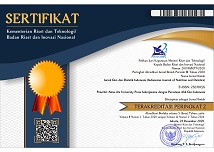Faktor yang berhubungan dengan preferensi konsumen street food pada mahasiswa Universitas Gadjah Mada
Abstract
ABSTRACT
Background: Habits and preferences influence the street food consumption. Consuming of foods that are high in fat, protein, and carbohydrate could increase the risk to suffered from coronary heart diseases, high blood pressure, diabetes mellitus, and stroke. More than 90% diseases that occurs in human were caused by food contamination of microorganisms, likes typhus and hepatitis A.
Objectives:To analyze factors related to street food consumer preferences of Universitas Gadjah Mada’s students.
Methods:This was an observational research with cross sectional design. Samples were 96 UGM’s undergraduate students of the year 2012 taken by cluster sampling. Datas were obtained by interview using questionnaire consumer preferences of street food and the individual and food characteristics. Data were then analysed by statistical analysis using correlation test (contingency coeffi cient and Spearman) and multivariate analysis using logistic regression.
Results: There was correlation between sex (RR:1.60, p=0.012), income (RR:1.36, p=0.017) and food prices (RR:0.52, p=0.001) with preference of street food meal.There was correlation between knowledge about nutrition (RR:27.75, p=0.000) and hygiene and sanitation (RR:1.25, p=0.000) with preference of street food on fruit group at Universitas Gadjah Mada’s students.
Conclusions: Sex, income, and food prices related to preference of street food on meal. Knowledge about nutrition and hygiene sanitation related to preference of fruit group street food of Universitas Gadjah Mada’s students.
KEYWORDS: food preference, consumer, street food, university students
ABSTRAK
Latar belakang: Kebiasaan dan preferensi seseorang akan sangat mempengaruhi konsumsi street food. Mengonsumsi makanan tinggi lemak, protein, dan karbohidrat dapat meningkatkan risiko terserang penyakit jantung koroner, tekanan darah tinggi, diabetes mellitus, dan stroke. Lebih dari 90% penyakit yang terjadi pada manusia disebabkan oleh kontaminasi mikroorganisme melalui makanan seperti penyakit tifus dan hepatitis A.
Tujuan: Menganalisis faktor-faktor yang berhubungan dengan preferensi konsumen street food pada mahasiswa Universitas Gadjah Mada.
Metode: Jenis penelitian observasional dengan rancangan cross sectional. Sampel penelitian sebesar 96 orang mahasiswa S1 Universitas Gadjah Mada angkatan 2012 yang diambil secara cluster sampling. Data diperoleh dengan wawancara menggunakan kuesioner preferensi konsumen street food, karakteristik individu, dan makanan.Analisis bivariat menggunakan uji korelasi yaitu koefi sien kontingensi dan Spearman, sedangkan analisis multivariat menggunakan regresi logistik.
Hasil: Hasil analisis menunjukkan bahwa jenis kelamin (RR:1,60, p=0,012), pendapatan RR:1,36, p=0,017), dan harga makanan (RR:0,52, p=0,001) merupakan faktor yang berhubungan dengan preferensi konsumen street food kelompok menu utama (RR:27,75, p=0,000), sedangkan pengetahuan gizi dan higiene sanitasi makanan (RR:1,25, p=0,000) merupakan faktor yang berhubungan dengan preferensi konsumen street food kelompok buah-buahan pada mahasiswa Universitas Gadjah Mada.
Kesimpulan: Jenis kelamin, pendapatan, dan harga makanan berhubungan dengan preferensi konsumen street food kelompok menu utama. Pengetahuan gizi dan higiene sanitasi berhubungan dengan preferensi konsumen street food kelompok buah-buahan pada mahasiswa Universitas Gadjah Mada.
KATA KUNCI: preferensi makan, konsumen, street food, mahasiswa
Keywords
Full Text:
PDFReferences
Suhardjo. Sosio budaya gizi. Bogor: Departemen Pendidikan dan Kebudayaan Dirjen Pendidikan Tinggi, Pusat Antar Universitas Pangan dan Gizi, IPB, Bogor; 1989.
Gibney M, Jiyce T, McCarthy. Correlation between energy from added sugars and frequency of added sugars intake in Irish children, teenagers, and adults. J Nutr.2008;99(5):1117–26.
Purwanti S. Perencanaan mutu untuk penderita kegemukan. Jakarta: Penebar Swadaya; 2002.
UGM E. 57% pencari kerja lulusan PT gagal tes kesehatan [Internet]. 2010 [cited 2013 Nov 13]. Available from: http://ugm.ac.id/en/post/page?id=2543.
Winarno F. Keamanan pangan jilid 2. Bogor: M-Brio Press; 2004.
Shepherd R, Sparks. Modelling food choice. Glasgow: Blackie Academic and Profesional; 1994.
Huzaynah, Shelly. Analisis perilaku mahasiswa Sarmag Universitas Gunadarma Simatupang dalam pemilihan makan siang [Internet]. 2010.Available from: http://wartawarga.gunadarma.ac.id/2010/07/analisis-perilaku-mahasiswasarmag-universitas-gunadarma-simatupangdalam-pemilihan-makan-siang/
Boek, Stacey, Stephanie, Kenny C, Keiko G. Gender and race are significant determinants of students’ food choices on a college campus.J Nutr Educ Behav. 2012;44:372–8.
Yang, Yongbin, D B, Judd, Suzzanne, Gower, et al. Favorite foods of older adults living in the black belt region of the United States Influences of ethnicity, gender, and education. Appetite.2013;63:18–23.
Irala E, Groth, Johansson, Oltersdorf, Prattala, Martinez G. A systematic review of socioeconomic differences in food habits in Europe:consumption of fruit and vegetables. Eur J Clin Nutr. 2000;54:706–14.
Glanz K, Sallis J, Saelens B, Frank L. Nutrition environment measures survey in stores (NEMS-S): development and evaluation. Am J Prev Med. 2007;32(4):282–9.
Moore L V., Diez Roux A V. Associations of neighborhood characteristics with the location and type of food stores. Am J Public Health [Internet]. 2006;96(2):325–31. Available
from: http://ajph.aphapublications.org/doi/abs/10.2105/AJPH.2004.058040
Powell L, Auld C, Chaloupka F, O’Malley P, Johnston L. Associations between access to food stores and adolescent body mass index. Am J Prev Med. 2007;33(4):S301–7.
Franco M, Roux A, Glass T, Caballero B, Brancati F. Neighborhood characteristics and availability of Healthy Foods in Baltimore. Am J Prev Med. 2008;35(6):561–7.
Irawati, Damanhuri, Fachrurozi. Pengetahuan gizi murid SD dan SLTP di Kotamadya Bogor. Bogor: Pusat Penelitian Gizi Bogor; 1995.
Marsum W. Restoran dan segala permasalahannya edisi 4. Yogyakarta: Andi Offset; 2005.
Marriott N, Gravani RB. Principles of food sanitation fifth edition. New York: Springer Science Bussiness Media, Inc; 2006.
Martiani D. Kebiasaan jajan dan preferensi terhadap makanan jajanan pada mahasiswa IPB di Wilayah Dramaga. Institut Pertanian Bogor;2000.
Misnadiarly. Etiologi diare pada turis dan anak-anak sekolah di beberapa negara di dunia. Maj Kesehat Masy Indones. 1995;23(2):124–7.
Tiyas, Yanni T. Preferensi pangan anak sekolah di Kota Bogor. Institut Pertanian Bogor; 2009.
Sharkey J, Horel S. Characteristic of potential spatial access to a variety of fruits and vegetables in a large rural area. National Poverty Center/Economic Research Service, USDA Conference.2009.
DOI: http://dx.doi.org/10.21927/ijnd.2015.3(3).131-138
Refbacks
- There are currently no refbacks.
Indonesian Journal of Nutrition and Dietetics (IJND) indexed by:
 View My Stats
View My Stats



12.png)


























